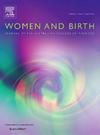加强助产士和产科医生之间的合作:一项定性内容分析研究
IF 4.1
2区 医学
Q1 NURSING
引用次数: 0
摘要
问题在瑞士和其他医疗保健系统中,助产士和产科医生之间的合作还没有充分发展。产科护理方面的合作影响分娩结果。以前的研究集中在合作的决定因素上,但如何促进跨专业分娩护理仍不清楚。目的本研究旨在确定加强助产士和产科医生之间合作的策略。方法对瑞士德语区三家急症护理医院的助产士和产科医生进行定性内容分析研究。通过焦点小组访谈收集数据,并采用Graneheim和Lundman的归纳内容分析进行分析。6名助产士和9名产科医生参与了调查。瑞士产房的助产士和产科医生之间出现了三种七种策略,可以加强他们之间的合作:(1)相互了解,(2)建立信任关系,(3)为合作实践创造安全的实践环境。讨论研究结果强调了促进早期相互理解专业角色、责任和护理理念的必要性。通过公开沟通和共同决策建立信任被认为对有效协作至关重要。早期和持续的教育、培训和专业发展的联合机会是必要的。系统的、结构性的支持是必要的,包括共享的工作流程、建立的、跨专业的沟通结构和促进心理安全的领导。组织承诺对于在实践中嵌入协作至关重要。结论加强孕产妇保健合作需要多层次的途径。努力的重点应放在跨专业学习、相互理解角色、建立信任的做法和支持性的制度结构上。领导模式的包容性行为和减少感知等级是加强合作的关键。本文章由计算机程序翻译,如有差异,请以英文原文为准。
Enhancing collaboration between midwives and obstetricians: A qualitative content analysis study
Problem
Collaboration between midwives and obstetricians is insufficiently developed in Swiss and other healthcare systems.
Background
Collaboration in maternity care impacts birth outcomes. Previous studies have focused on determinants of collaboration, but it remains unclear how to promote interprofessional birthing care.
Aim
This study aimed to identify strategies for enhancing collaboration between midwives and obstetricians.
Methods
We conducted a qualitative content analysis study with midwives and obstetricians in three acute care hospitals in the German-speaking part of Switzerland. Data were collected through focus group interviews and analysed using inductive content analysis following Graneheim and Lundman.
Findings
Eleven midwives and nine obstetricians participated. Three strategies with seven categories emerged that might enhance collaboration between midwives and obstetricians on Swiss labour wards: (1) getting to know each other, (2) building trustful relationships, and (3) creating safe practice environments for collaborative practice.
Discussion
The findings highlight the need to promote early mutual understanding of professional roles, responsibilities, and care philosophies. Trust-building through open communication and shared decision-making was considered vital for effective collaboration. Early and ongoing joint opportunities for education, training, and professional development is required. Systemic, structural support is necessary, including shared workflow, established, interprofessional communication structures, and leadership that fosters psychological safety. Organisational commitment is essential to embedding collaboration in practice.
Conclusion
Enhancing collaboration in maternity care requires a multi-level approach. Efforts should focus on interprofessional learning, mutual understanding of roles, trust-building practices, and supportive institutional structures. Leadership that models inclusive behaviours and reduces perceived hierarchies is key to strengthening collaboration.
求助全文
通过发布文献求助,成功后即可免费获取论文全文。
去求助
来源期刊

Women and Birth
NURSING-OBSTETRICS & GYNECOLOGY
CiteScore
7.20
自引率
13.20%
发文量
371
审稿时长
27 days
期刊介绍:
Women and Birth is the official journal of the Australian College of Midwives (ACM). It is a midwifery journal that publishes on all matters that affect women and birth, from pre-conceptual counselling, through pregnancy, birth, and the first six weeks postnatal. All papers accepted will draw from and contribute to the relevant contemporary research, policy and/or theoretical literature. We seek research papers, quality assurances papers (with ethical approval) discussion papers, clinical practice papers, case studies and original literature reviews.
Our women-centred focus is inclusive of the family, fetus and newborn, both well and sick, and covers both healthy and complex pregnancies and births. The journal seeks papers that take a woman-centred focus on maternity services, epidemiology, primary health care, reproductive psycho/physiology, midwifery practice, theory, research, education, management and leadership. We also seek relevant papers on maternal mental health and neonatal well-being, natural and complementary therapies, local, national and international policy, management, politics, economics and societal and cultural issues as they affect childbearing women and their families. Topics may include, where appropriate, neonatal care, child and family health, women’s health, related to pregnancy, birth and the postpartum, including lactation. Interprofessional papers relevant to midwifery are welcome. Articles are double blind peer-reviewed, primarily by experts in the field of the submitted work.
 求助内容:
求助内容: 应助结果提醒方式:
应助结果提醒方式:


